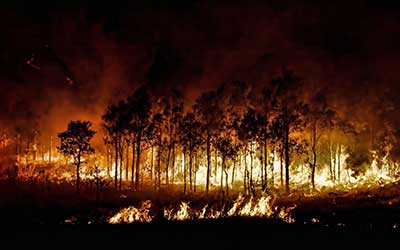Relevance: GS-3: Conservation, environmental pollution and degradation, environmental impact assessment
Key Phrases: Simlipal Tiger Reserve in Odisha, global wildfire crisis report, Paris Climate Accord, World Wide Fund, Food and Agriculture Organisation, Indian Institute of Technology Mandi.
Context:
- Last year, large blazes in Simlipal Tiger Reserve in Odisha and Uttarakhand, which destroyed ecosystems of species from the microscopic to the magnificent, releasing thousands of tonnes of carbon, raised vital questions on forest fires mitigation approaches.
- A new UN report describes a “global wildfire crisis" trend increasing both spatially and temporally - primarily because of climate change.
- In India, data on forest fires issues are very fragmented or scarce and sketchy. This affects critical decision-making.
Major Forest Fires in 2021:
- Wildfires in Siberia affected the western region , nearly 40 million acres of land have burned down in Siberia.
- North America saw extreme temperature and heat waves in autumn.Canada recorded a temperature of 49.6 degrees Celsius, causing a series of wildfires.
- The Mediterranean region suffered major wildfires leading to an increase in PM levels up to 2.5. Turkey, Tunisia and Italy suffered due to the worst wildfires.
What will be the holistic approach to control forest fires according to the Editorial?
- UNEP: Resolve constructively the dilemma of Tribal Livelihood vs
Forest conservation:
- As part of the Paris Climate Accord, the Indian government committed to adding forests and tree cover as “carbon sinks” to absorb 2.5-3 billion tonnes of CO2 equivalents by 2030.
- On the livelihoods front, 300 million Indians depend on forests for their subsistence and jobs, according to the Food and Agriculture Organisation.
- These tribal and local communities live in forests or on their fringes, and face blame for forest burning, because those who have the least power and voice are often cast as the villains.
- World Wide Fund NGO: Tribals and Local knowledge can do miracles in
curbing Forest Fires:
- An emerging understanding from ecologists and grassroots organisations indicates how communities can be allies in arresting and preventing fires.
- In Simlipal, for instance, tribal people were on the frontline of controlling forest fires last year and as this summer looms, women’s self-help groups have been clearing the brush and creating fire lines.
- For centuries, forest-dependent communities across the world have fine-tuned a balance between their needs and the natural world’s regeneration.
- India's Top to Bottom approach against ecological principle of local
participation:
- In India, for a very long time , a colonial forestry model, which now has transitioned into a fortress-style conservation model, has kept communities out.
- Communities marginalisation results in an energy poverty that leaves many tribal communities dependent on firewood for basic needs like cooking in the 21st century.
- Fire is integral to tribal socio-cultural practices:
- Fire is central to communities’ culture and socio-economic cycles.
- For instance, in sal forests of central India, Baiga and Gond communities light fires under mahua trees while they wait to gather the pale yellow flowers that fall on the ashen earth. These small blazes keep them warm and keep potential rivals like bears away from the mahua harvest.
- A golden blend of Modern Research and Traditional Knowledge needed:
- Forest fires complexities require fusing contemporary knowledge with scientific contextual needs.
- For instance, researchers at the Indian Institute of Technology Mandi have tested an intervention that makes the alpine forests of the Himalayan foothills less susceptible to forest fires and provides local livelihoods.
- Based on these studies, communities in Himachal Pradesh have set up businesses that gather and process highly flammable dry chir pine needles into bio-pellets that can be fired with or instead of coal in industrial processes.
Do you remember California Forest Fires?
- The USA forest department ignored Native Americans’ knowledge about periodic controlled burns.
- California's tribals claim that “Good fire” of low to moderate intensity may reduce the fuel for larger blazes and aid germination of plants whose seeds need fire to crack open.
- But officials ignored them, this led to the consequences of a massive build-up of flammable stock that combusts in mega blazes like in California in 2021.
Way Forward:
- Spread awareness in communities regarding problematic tribal
practices:
- Stubble burning in forest-adjacent fields
- Sinister issues like intentional arson to clear forest land for agriculture.
- Forests continue to be central to our civilization by shaping our air and rivers and to how pollinators give life to the fields that feed us and are a source of immense aesthetic and spiritual value.
- Communities’ knowledge and customs should be central to fight forest
fires:
- In combating wildfires, we can no longer continue to ignore the critical role of our allies — the forest dwellers and tribal communities.
- Tribal communities have a strong intuitive understanding to control forest fires. There is much to learn from them how their traditional practices with sustainable usage of natural resources can help to reduce this disaster.
- India’s varied forest habitat is a giant tinderbox that can release vast amounts of carbon dioxide, imperilling lives and livelihoods. But, if safeguarded and thoughtfully expanded, these very forests could be vital in slowing down the world’s warming by drawing down greenhouse gases from the atmosphere.
- To combat forest fires, India will also need to improve coordination between ministries and agencies at the union and state levels to ensure contextually appropriate interventions that can be delivered by the forest department and local administrations.
- Technical knowledge should also be decentralised so that people on the ground have access to information that helps them respond to disasters and build resilience in the long term.
Source: Indian Express
Mains Question:
Q. Examine the different causes of Forest Fires in India. Bring out the significance of forest dwellers and tribal communities' traditional learnings in reducing the problem of forest fires. (10 marks).






















